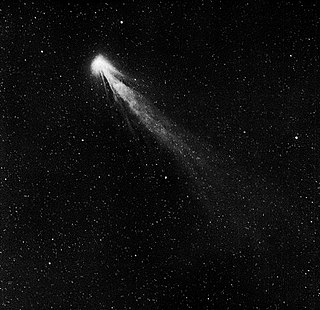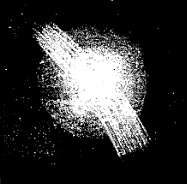Related Research Articles
Near-Earth Asteroid Tracking (NEAT) was a program run by NASA and the Jet Propulsion Laboratory, surveying the sky for near-Earth objects. NEAT was conducted from December 1995 until April 2007, at GEODSS on Hawaii, as well as at Palomar Observatory in California. With the discovery of more than 40 thousand minor planets, NEAT has been one of the most successful programs in this field, comparable to the Catalina Sky Survey, LONEOS and Mount Lemmon Survey.

Gordon John Garradd is an Australian amateur astronomer and photographer from Loomberah, New South Wales. He has discovered numerous asteroids and comets, including the hyperbolic comet C/2009 P1, and four novae in the Large Magellanic Cloud. The asteroid and Mars-crosser, 5066 Garradd, was named in his honour.

Comet Humason, formally designated C/1961 R1, was a non-periodic comet discovered by Milton L. Humason on September 1, 1961. Its perihelion was well beyond the orbit of Mars, at 2.133 AU. The outbound orbital period is about 2516 years. The diameter of its comet nucleus is estimated at around 30−41 km.

In astronomy, precovery is the process of finding the image of an object in images or photographic plates predating its discovery, typically for the purpose of calculating a more accurate orbit. This happens most often with minor planets, but sometimes a comet, a dwarf planet, a natural satellite, or a star is found in old archived images; even exoplanet precovery observations have been obtained. "Precovery" refers to a pre-discovery image; "recovery" refers to imaging of a body which was lost to our view, but is now visible again (also see lost minor planet and lost comet).
Comet Skjellerup–Maristany, formally designated C/1927 X1, 1927 IX, and 1927k, was a long-period comet which became very bright in 1927. This great comet was observable to the naked eye for about 32 days. It was independently discovered by amateur astronomers John Francis Skjellerup in Australia on November 28, 1927 and Edmundo Maristany in Argentina on December 6, 1927, and noted for its strong yellow appearance, caused by emission from sodium atoms.

Comet 4P/Faye is a periodic Jupiter-family comet discovered in November 1843 by Hervé Faye at the Royal Observatory in Paris. Its most recent perihelia were on November 15, 2006; May 29, 2014; and September 8, 2021.
47P/Ashbrook–Jackson is a periodic comet in the Solar System.
The Comet of 1729, also known as C/1729 P1 or Comet Sarabat, was an assumed parabolic comet with an absolute magnitude of −3, the brightest ever observed for a comet; it is therefore considered to be potentially the largest comet ever seen. With an assumed eccentricity of 1, it is unknown if this comet will return in a hundred thousand years or be ejected from the Solar System.

Comet 96P/Machholz or 96P/Machholz 1 is a short-period sungrazing comet discovered on May 12, 1986, by amateur astronomer Donald Machholz on Loma Prieta peak, in central California using 130 millimetres (5.1 in) binoculars. On June 6, 1986, 96P/Machholz passed 0.40373 AU from the Earth. 96P/Machholz last came to perihelion on October 27, 2017, and will next come to perihelion on January 31, 2023. The comet has an estimated diameter of around 6.4 km (4.0 mi).

C/2007 E2 (Lovejoy) is a non-periodic comet discovered by Terry Lovejoy on 15 March 2007. Its perihelion was 27 March 2007, while its closest approach to Earth was 25 April 2007 in Hercules at a distance of 0.44 AU. Maximum apparent magnitude was approximately +8.

Terry Lovejoy is an information technologist from Thornlands, Queensland, Australia, most widely known as an amateur astronomer. He has discovered six comets, including C/2011 W3 (Lovejoy), the first Kreutz Sungrazing comet discovered by ground-based observation in over 40 years. He is also known for popularizing procedures for modifying consumer-grade digital cameras so that they can be used for digital camera astrophotography.
Comet 322P/SOHO, also designated P/1999 R1, P/2003 R5, P/2007 R5, and P/2011 R4, is the first periodic comet to be discovered using the automated telescopes of the SOHO spacecraft, and second to be given a numbered designation, after 321P/SOHO. JPL Horizons next predicts 322P to come to perihelion at 2019-Aug-31 12:25 UT.

A minor planet is "lost" when today's observers cannot find it, because its location is too uncertain to target observations. This happens if the orbital elements of a minor planet are not known accurately enough, typically because the observation arc for the object is too short, or too few observations were made before the object became unobservable.

(4953) 1990 MU is a large Earth-crossing asteroid (ECA) belonging to the Apollo group of near-Earth objects which also cross the orbits of Mars and Venus. At approximately 3 km in diameter, it is one of the largest known ECAs. It has been assigned a permanent number from the Minor Planet Center (4953) indicating that its orbit has been very well determined. With an observation arc of 45 years, the asteroid's trajectory and uncertainty regions are well known through to the year 2186.

The Great Comet of 1823, also designated C/1823 Y1 or Comet De Bréauté-Pons, was a bright comet visible in the last month of 1823 and the first months of 1824.

Comet Lovejoy, formally designated C/2011 W3 (Lovejoy), is a long-period comet and Kreutz sungrazer. It was discovered in November 2011 by Australian amateur astronomer Terry Lovejoy. The comet's perihelion took it through the Sun's corona on 16 December 2011, after which it emerged intact, though greatly impacted by the event.
163P/NEAT is a periodic comet discovered on November 5, 2004 by Near-Earth Asteroid Tracking (NEAT) using the 1.2 meter Samuel Oschin telescope at Palomar Observatory.
In observational astronomy, the observation arc of a Solar System body is the time period between its earliest and latest observations, used for tracing the body's path. It is usually given in days or years. The term is mostly used in the discovery and tracking of asteroids and comets. Arc length has the greatest influence on the accuracy of an orbit. The number, spacing of intermediate observations, and timestamps have a lesser effect.
Claudine Rinner is a French amateur astronomer from Ottmarsheim in Alsace, France. She is an observer at Ottmarsheim Observatory and a discoverer of minor planets and comets, who received the Edgar Wilson Award for her discoveries.
References
- ↑ "C/2007 K5 (Lovejoy)". JPL Small-Body Database Browser. NASA.gov. 14 December 2011. Retrieved 15 December 2011.
- ↑ Yoshida, Seiichi (23 September 2007). "C/2007 K5 ( Lovejoy )". Comet Catalog. Retrieved 16 December 2011.

